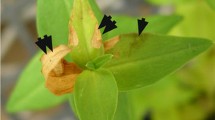Abstract
HealthyVinca rosea plants, connected by dodder strands with spike-diseased sandal trees developed witches' broom symptoms. Electron microscopy of petioles of the infectedVinca plants revealed the presence of numerous mycoplasma-like bodies. Fresh dodder established on theVinca plants with witches' broom symptoms and trained onto healthy sandal trees, transmitted the spike disease back to the latter.
Samenvatting
De ‘spike’-ziekte van de sandelboom (Santalum album) behoort tot de heksenbezemziekten. Zoals eerder werd aangetoond bevatten door deze ziekte aangetaste sandelbomen mycoplasma-achtige lichaampjes in het floëem van takken en bladeren.
Daar alleen met zekerheid bekend is dat de ziekte door enting op gezonde sandelbomen kan worden overgebracht, is nagegaan of met behulp van warkruid (Cuscuta subinclusa) andere plantesoorten konden worden geïnfecteerd.
Vijf tot tien weken nadat zich op gezonde planten vanVinca rosea utilopers van het warkruid, afkomstig van ‘spike’-zieke sandelbomen hadden gehecht, hielden deVinca-planten op met bloeien en vertoonden de bladeren nerfglazigheid en tussennervige chlorose; op sommige planten werd eveneens fyllodie waargenomen. Enige tijd later ontwikkelden zich aan scheuten van uitgelopen okselknoppen kleine, smalle, geelgroene blaadjes (Fig. 1). Na ongeveer 16–20 weken verwelkten deVinca-planten en stierven af. Werden oudere planten geïnfecteerd dan bestonden de heksenbezemsymptomen hoofdzakelijk uit fyllodie, apicale rozetten en lichte bladvergeling (Fig. 2).
Door opnieuw warkruid te laten groeien op de ziek gewordenVinca-planten en uitlopers van de parasiet te leiden naar gezonde sandelbomen verschenen ongeveer 16 weken nadat het warkruid zich op laatstgenoemde had gehecht typische ‘spike’-symptomen op een van de twee bomen (Fig. 3).
Elektronenmicroscopisch onderzoek van bladsteeltjes van vergeeldeVinca-blaadjes gaf een groot aantal mycoplasma-achtige lichaampjes van verschillende vorm en afmeting te zien (Fig. 4 en 5).
Hiermee is aangetoond, dat de ‘spike’-ziekte van de sandelboom door warkruid kan worden overgebracht opVinca rosea en weer terup op sandel en dat ook inVinca de symptomen samengaan met het voorkomen van mycoplasma-achtige lichaampjes.
Similar content being viewed by others
References
Anonymous, 1993. Insect transmission of spike disease. Nature, Lond. 132: 592–593.
Coleman, L. C., 1917. Spike disease of sandal. Bull. Dep. Agric. Mysore, Mycol. Ser. 3: 1–52.
Coleman, L. C., 1923. The transmission of sandal spike. Indian Forester 49: 6–9.
Dijkstra, J. & Ie, T. S., 1969. Presence of Mycoplasma-like bodies in the phloem of sandal affected with spike disease. Neth. J. Pl. Path. 75: 374–378.
Hull, R., Horne, R. W. & Hayar, R. M., 1969. Mycoplasma-like bodies associated with sandal spike disease. Nature, Lond. 224: 1121–1122.
Mollenhauer, H. H., 1964. Plastic embedding mixtures for use in electron microscopy. Stain Technol. 39: 111–114.
Narasimhan, M. J., 1954. Studies on the spike disease of sandal (Santalum album). Indian Forester 80: 690–691.
Rangaswami, (Rao Sahib) S. & Griffith, A. L., 1941. Demonstration ofJassus indicus (Walk) as a vector of the spike disease of sandal (Santalum album, Linn.). Indian Forester 67: 387–394.
Rangaswami Iyengar, (Rao Sahib) S. & Griffith, A. L., 1939. Entomological investigations on the spike disease of sandal (35). Further studies on the spike disease of sandal. Indian Forest Rec. 6: 85–171.
Rangaswami, S. & Sreenivasaya, M., 1935. Insect transmission of spike disease of sandal (Santalum album, Linn.). Curr. Sci. 4: 17–19.
Reynolds, E. S., 1963. The use of lead citrate at high pH as an electron-opaque stain in electron microscopy. J. Cell Biol. 17: 208–212.
Sreenivasaya, M., 1930. Contributions to the study of spike disease of sandal (Santalum album Linn.). XI. New methods of disease transmission and their significance. J. Indian Inst. Sci. 13: 113–117.
Varma, A., Chenulu, V. V., Raychaudhuri, S. P., Prakash, N. & Rao, P. S., 1969. Mycoplasma-like bodies in tissues infected with sandal spike and brinjal little leaf. Indian Phytopath. 22: 289–291.
Author information
Authors and Affiliations
Rights and permissions
About this article
Cite this article
Dijkstra, J., Lee, P.E. Transmission by dodder of sandal spike disease and the accompanying mycoplasma-like organisms via Vinca rosea. Netherlands Journal of Plant Pathology 78, 218–224 (1972). https://doi.org/10.1007/BF01977322
Accepted:
Issue Date:
DOI: https://doi.org/10.1007/BF01977322




